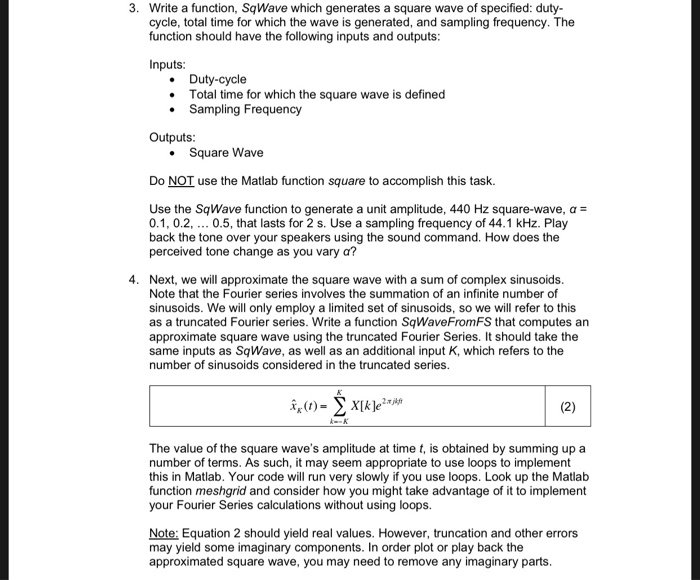
Only do number 4!! Must only write in Matlab. Use same parameters that are used in number 3. Can not use built in function square().
3. Write a function, SqWave which generates a square wave of specified: duty- cycle, total time for which the wave is generated, and sampling frequency. The function should have the following inputs and outputs Inputs: Duty-cycle Total time for which the square wave is defined Sampling Frequency Outputs . Square Wave Do NOT use the Matlab function square to accomplish this task. Use the SqWave function to generate a unit amplitude, 440 Hz square-wave, ? 0.1, 0.2,.. 0.5, that lasts for 2 s. Use a sampling frequency of 44.1 kHz. Play back the tone over your speakers using the sound command. How does the perceive d tone change as you vary a? 4. Next, we will approximate the square wave with a sum of complex sinusoids Note that the Fourier series involves the summation of an infinite number of sinusoids. We will only employ a limited set of sinusoids, so we will refer to this as a truncated Fourier series. Write a function SqWaveFromFS that computes an approximate square wave using the truncated Fourier Series. It should take the same inputs as SqWave, as well as an additional input K, which refers to the number of sinusoids considered in the truncated series. The value of the square wave's amplitude at time t, is obtained by summing up a number of terms. As such, it may seem appropriate to use loops to implement this in Matlab. Your code will run very slowly if you use loops. Look up the Matlab function meshgrid and consider how you might take advantage of it to implement your Fourier Series calculations without using loops. Note: Equation 2 should yield real values. However, truncation and other errors may yield some imaginary components. In order plot or play back the approximated square wave, you may need to remove any imaginary parts 3. Write a function, SqWave which generates a square wave of specified: duty- cycle, total time for which the wave is generated, and sampling frequency. The function should have the following inputs and outputs Inputs: Duty-cycle Total time for which the square wave is defined Sampling Frequency Outputs . Square Wave Do NOT use the Matlab function square to accomplish this task. Use the SqWave function to generate a unit amplitude, 440 Hz square-wave, ? 0.1, 0.2,.. 0.5, that lasts for 2 s. Use a sampling frequency of 44.1 kHz. Play back the tone over your speakers using the sound command. How does the perceive d tone change as you vary a? 4. Next, we will approximate the square wave with a sum of complex sinusoids Note that the Fourier series involves the summation of an infinite number of sinusoids. We will only employ a limited set of sinusoids, so we will refer to this as a truncated Fourier series. Write a function SqWaveFromFS that computes an approximate square wave using the truncated Fourier Series. It should take the same inputs as SqWave, as well as an additional input K, which refers to the number of sinusoids considered in the truncated series. The value of the square wave's amplitude at time t, is obtained by summing up a number of terms. As such, it may seem appropriate to use loops to implement this in Matlab. Your code will run very slowly if you use loops. Look up the Matlab function meshgrid and consider how you might take advantage of it to implement your Fourier Series calculations without using loops. Note: Equation 2 should yield real values. However, truncation and other errors may yield some imaginary components. In order plot or play back the approximated square wave, you may need to remove any imaginary parts
 Only do number 4!! Must only write in Matlab. Use same parameters that are used in number 3. Can not use built in function square().
Only do number 4!! Must only write in Matlab. Use same parameters that are used in number 3. Can not use built in function square(). 





